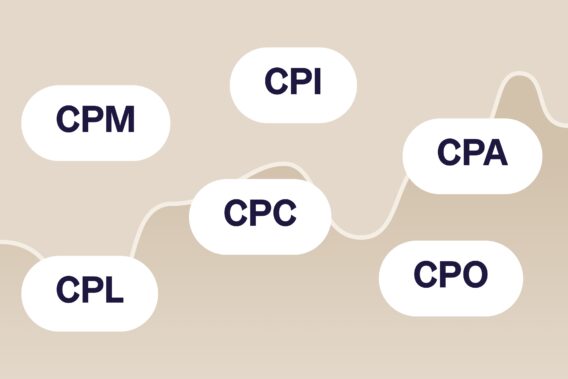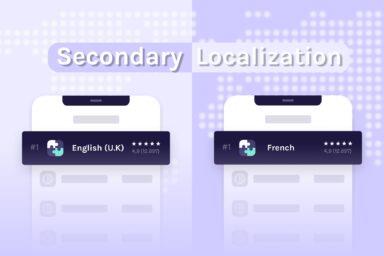6 Basic Mobile App Marketing terms for User Acquisition beginners
One of the biggest challenges app owners face is commonly the part after creation. Effective marketing and promotion of a mobile app are crucial for a successful business.

If you are looking for ways to advertise your app, you need to think about what strategy to follow. A successful app advertisement campaign isn’t only about getting lots of installs. You can pursue different goals depending on the current state of your app marketing strategy.
We got some of the most crucial app marketing strategies and ad pricing models summarized for you in this article. As a bonus, we show you how to increase your organic app installs.
7 ways to drive traffic to your app
There are several ways to advertise and promote your mobile app. To get started, we have some summarized here:
- App Store Optimization (ASO)
- Social Media Marketing
- Content Marketing
- PR & Guest Blogging / Backlinks
- Paid User Acquisition using Ad Networks
- Paid App Store Search Ads
- Influencer Marketing
App Marketing & Pricing Models
When you think about mobile app marketing, terms like CPI, CPL or CPC might come straight into your mind. But what is the best way to pay for app ads and what do all these abbreviations actually mean? To answer this question, you first have to ask yourself: What exactly do I want to achieve with my app marketing campaign? With every digital marketing model, there are pros and cons according to your strategy. The best way to define how you are going to pay for your campaign is to know your goals and, therefore, which results you expect from the ads used in the campaign.
What is Cost Per Thousand (CPM)?
To understand this model, you must know the difference between impression and page views.
An Impression is a metric system to measure the number of times your ad was displayed on a website. Your ad might have more impressions than page views since it can be in more than two banners on the same page. So, in one pageview you may have two impressions because your ad was displayed twice.
For every thousand of impressions your ad has, you pay x amount of money. That is merely the cost. CPM campaigns are a useful type of advertisement if you are starting in the app industry and don’t have an established brand. When you pay for the impression, you are paying for visibility, making people see you all the time and stick with you. The more your ad shows up to the same person, the more your brand will be in his/her mind. Hence, there are more chances that they will look for you when they need the product you offer.
What is Cost Per Install (CPI)?
This is a type of ad that commands you to target your audience. Every time someone downloads your app, you are going to pay for it. For this kind of advertisement, you must understand which audience you want to reach. Based on who they are, you are going to know where to find them, in other words, how and where to promote yourself.

Doing CPI ads, your ad must have a great call-to-action and should show the potential user your main features. You have to explore the quality of traffic. However, do not forget that driving merely users that uninstall your app already five days later, is pretty bad. High churn rates can negatively influence your App Store Optimization efforts. The best KPI to use together with this type of ads is the Retention Rate.
CPI = how much you'll pay per install in your ad campaign
You can identify the people that downloaded your app from the ad and check how many of them kept using it and didn’t uninstall it. You know which kind of users like your app best by comparing the conversion rate of different cpi campaigns to find your target audience for high retention rates.
SEE ALSO: How to Find Your Target Audience
What is Cost Per Action (CPA)?
In CPA ad models, you pay for a specific action. For instance, the action chosen is In-App Purchase, so, you pay for each In-App Purchase. If the person clicks on the ad, downloads the app, but doesn’t make an In-App Purchase, you don’t spend any money on this new user.
Another possible scenario for CPA ads is, you can have a subscription model inside your app, and you want to pay for each client that enrolls in it. If the user keeps the usage free, you won’t pay for it.
CPA marketing is the best deal if you want to instigate the user to take some specific type of action inside your app. When you are creating the ad on Google AdWords, for instance, you can specify the action that equals a conversion. The cost is calculated by dividing the total cost of the campaign by conversions
CPA = total campaign cost / conversions
As we are talking about apps, it may be good to check if you are spending your money the right way. However, it all depends on the type of business. If you have an app per subscription and your CPA is lower than the lifetime value, you’re making a profit.
If you need your users to buy specific things inside your app, you must relate your CPA with the Return on Investment to analyze how successful your campaign was. The CPA might be low, but maybe the return isn’t what you expected.
What is Cost Per Click (CPC)?
Running CPC ads, you pay for each click your ad triggers.
When you create a CPC campaign via Google AdWords, you have to define how much you are willing to pay for each click. First of all, you are going to choose essential keywords that your ad must activate when written on the search tool. You have to select the bid for each keyword. For instance, my keyword is “calendar app” and my bid for it is $2,00. If someone searches for this keyword, sees your ad and clicks on it, you might pay max $2,00 for this action. However, depending on your competitors and your quality score, you might pay less. It depends on the Google algorithm. To avoid bankruptcy, you are going to provide Google with a maximum amount to spend per day. So, Google will control your budget.
CPC = how much you'll pay per click in your ad campaign
You have to be careful with this type of advertisement. The more clicks your ad receives, the more you are going to pay. If you invested in clicks but the download rate isn’t increasing, you can reach some conclusions: either you are targeting the wrong audience, or you need to optimize your app store page.
Be careful with this model, in order not to spend a lot of money for nothing (unless your idea is just to make people visit your app page).
What is Cost Per Order (CPO)?
CPO is the cost that you had to spend on each sale. This can be one action that you defined at the CPA. In this model, you understand how much money you spend to make a lead (the person that clicked on your ad) purchase your product. That means CPO basically describes how much money you spent to generate a single sale.
You can calculate the same way you did for the CPA: divide the costs by results.
CPO = total cost of campaign / number of orders
What is Cost Per Lead (CPL)?
As you can imagine, in this type of campaign you are interested in when focusing on lead generation. Running CPL campaigns is a good idea if you are about to launch a new app. So, you collect a lot of e-mails and send the newsletter when it is released or even send a voucher for making leads using the new app. Thus, you need a lead form and will pay when the form is completed and submitted. The idea is not to make users install an app but it is to get contacts and information at first instance.
CPL = Total cost for generating leads / number of leads created
To measure your success, you have to understand the quality of the leads you acquired. This campaign is to collect people who you can invest in later again. If the user doesn’t download your app or isn’t interested in what you have, then you must change your ad or your target audience.
Bonus: Strategies to Boost Your App Downloads & Leads Organically
When you wish to make the most out of your marketing budget, you should not forget about the following tactics to (further) increase your organic app downloads.
Why App Store Optimization (ASO) is important
About 67% of app downloads are initiated through organic app store search. People tend to search for apps by using the search functionality of the app stores. If you want to gain more users organically, you need to make sure your app is listed high in the right search results. Organic search is the most popular way to find apps and games in mobile app stores.
To ensure your target audience finds your app through search, you need to develop a sophisticated keyword strategy. That’s a crucial part of App Store Optimization.

SEE ALSO: How to Optimize Your ASO Keyword Strategy
Doing keyword optimization for ASO means strategically finding the right keywords and then placing them in a way that gives maximum exposure to your app. Enhance the following app store metadata fields with relevant keywords:
- App Title / App Name
- Subtitle
- App Description
- Keyword Field (iOS only)
The importance of A/B testing
The app store page is where users make their final decision on purchasing your app. To make the most out of both, your install campaigns and organic reach you need to make your app page shine. This is where you sell your app. Thus, by running a/b tests, you can find out, how to improve your visit to install rate. All assets shown on your app page (store listing) have a great impact on your conversion rate.
A/B testing or Split-testing is a method of comparing two hypotheses identifying which option performs better. You distribute an audience equally among two or more variations of app product page elements like for example screenshots or app title. When all audience members act naturally and are unaware of your testing, you can find the best version of your app page by analyzing conversion rate results.
SEE ALSO: How App A/B Testing Works
Sell your app to an international audience
Many developers start their business in their home country or in the U.S. first. That’s a fair thought. However, when you consider that 72 % of app users are not native English speakers, you might be missing lots of potential customers if you sell your app in one language (or just in English) only.
If you are familiar with the principles of App Store Optimization and use the right tools helping you through the ASO process, app store localization is a tactic you have to follow. App localization is the translation and adoption of metadata, visuals and product information to another language and culture.
Briefly, this means you optimize your app store screenshots, app title, videos and keywords for increasing rankings and downloads in app store markets abroad.
Final Thoughts
To sum up, you now know there are a lot of mobile app marketing strategies and pricing models. However, to choose the right one, it all comes down to your app marketing strategy.
- If you are in an initial stage of your app marketing, and maybe your app isn’t even available for download yet, go for a CPL campaign and make sure your app is found in relevant search results.
- If you want people to get to know your app, do some CPC marketing using various ad networks or influencer marketing.
- If you want people to download your app, make sure to have your app page assets tested for conversion rates before you run CPI campaigns.
We hope this guide helps you guys understand all the abbreviations and possibilities coming with an app marketing strategy. They may seem confusing, but actually, they all just refer to different goals of a campaign.
Monitor Global App Downloads
Sign up for App Radar

Latest Posts


